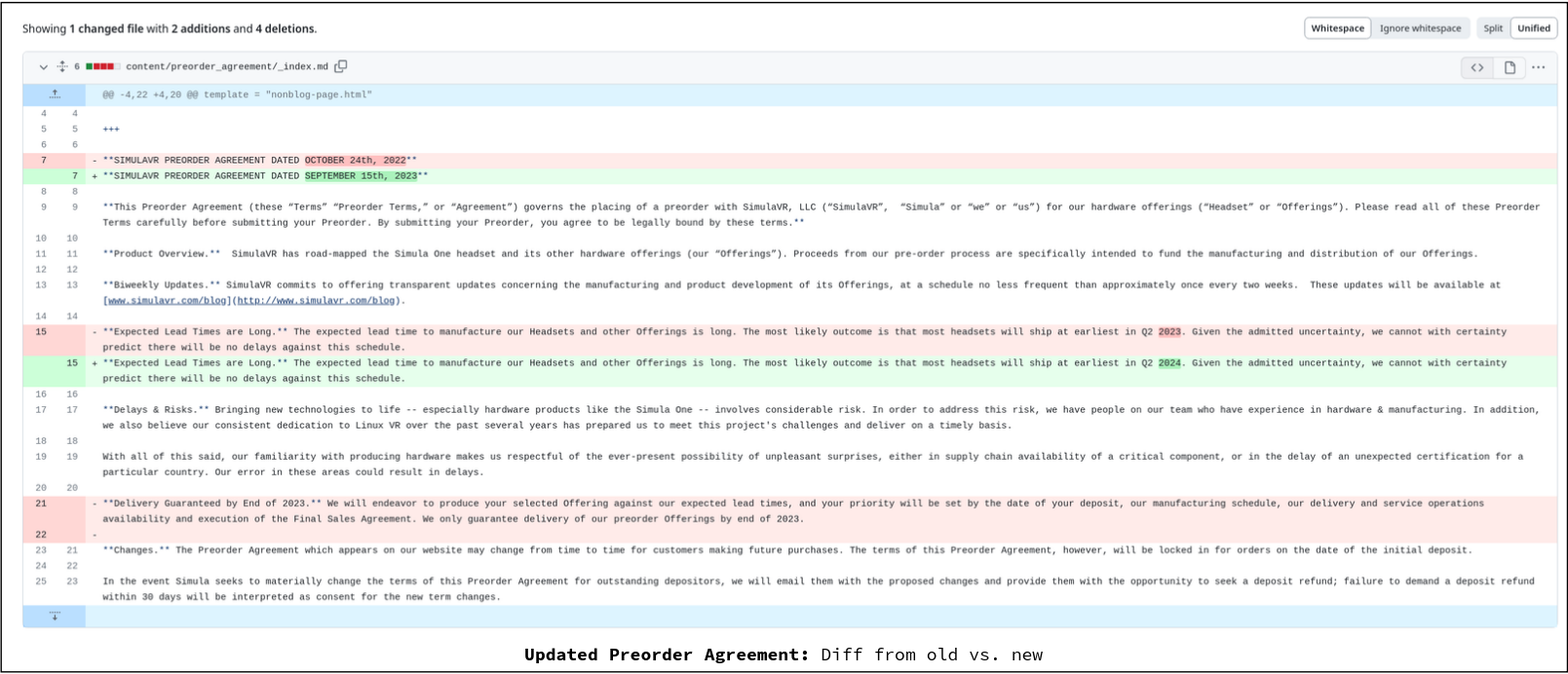In this post, we (i) post our reactions to the Apple Vision Pro, (ii) review some alterations we've recently made to our headset chassis (to improve user comfort and board/cable fit), and (iii) flag an update to our Preorder Agreement for new headset purchasers in 2024 and onward.
1 Apple Vision Pro: Closer Than Ever to a Laptop Replacement
Though seeing Apple ship their headset before ours has been bittersweet, we've still enjoyed seeing the overwhelming fanfare around the Vision Pro (henceforth "AVP"). Generally speaking, we're huge fans of First-In-Kind Devices, and though we still think Apple's headset falls short as a true laptop replacement, it's the closest device to such a thing on the market, by far. This is definitely a rising tide for those who want to eventually accelerate from their laptops to VR computers!
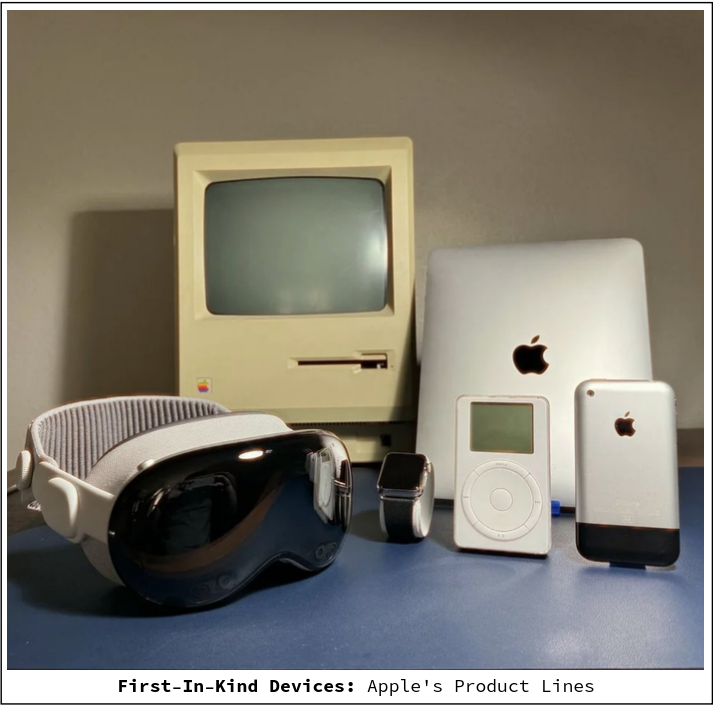
In terms of design and polish: there's no doubt that Apple has delivered something stellar. (You know, we've often said we wanted Simula's first headset to be like an Apple II for VR computing; well, the polish of Apple's Vision Pro might just make our first iteration headset actually look like...an Apple II :) With that said, we're particularly excited to see so much more consumer enthusiasm for VR's productivity use cases (something we rarely saw in the past with Meta's headsets):
I just spent almost 3 hours coding in Vision Pro. No discomfort, no fatigue… just pure bliss pic.twitter.com/STcQ0YCHPM
— austin blake (building productivity apps for iOS) (@austboston) February 3, 2024
After five days using the Vision Pro for extremely long straight hours: I decided to sell my monitor
— Brad Lynch (@SadlyItsBradley) February 7, 2024
XR hardware/software finally hit the threshold for me
We believe one of the main drivers for this enthusiasm is that the AVP has passed a pixel density usability threshold (which we think is around 30PPD, for most people), which makes reading text and other fine details finally good enough for sustained usage. With this threshold passed, the extra space in VR finally starts to allow for new workflows not previously available (on even the most expensive multimonitor rigs):
It's interesting being able to "flip back" a few pages with much less disruption to one's sense of "place."
— Andy Matuschak (@andy_matuschak) February 13, 2024
Also interesting: "I remember where that detail was on the page" -> "I remember where that page was in space"
(text is legible in headset, tho not in the exported video) pic.twitter.com/XLbevRZVhe
And then there's the portability aspects: being able to productively compute while in an airplane, repairing a car, cooking a recipe, walking your dog, or even while going to the bathroom is just all totally amazing (because who knows where creativity might strike? :). One particular thing we like is the ability to work while outside, without the hindrance of sunglare:
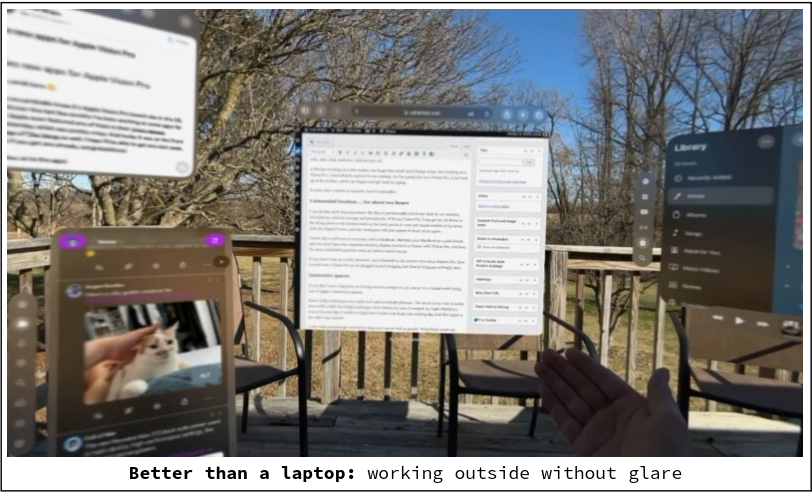
1.1 But is it a laptop replacement?
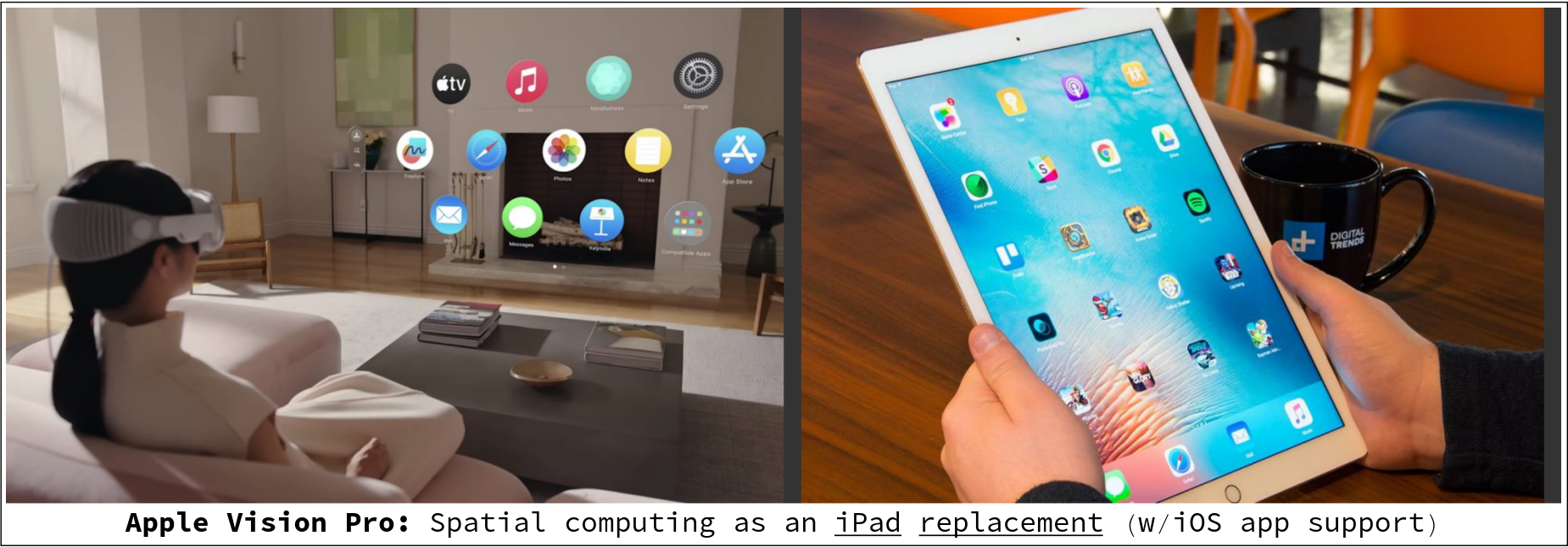
From our perspective, we still think the main problem with the AVP is that it only supports native iPad apps (at least for 2D apps), an issue frequently flagged in various posts about what it's like to work in one. For example, one user reports:
- I make the annotated screenshots for my how-to articles using the Apple Frames Shortcut, marking them up in Pixelmator Pro — neither of which are available in visionOS.
- Final Cut Pro and Logic Pro don’t run on visionOS. Even if they did, they would be the subscription-based iPad versions, which I don’t pay for. I bought the Mac versions years ago.
- Recording The CultCast uses a web app that only runs inside Chrome, not Safari.
- Apple announced that they’re allowing support for other browser engines, but only on the iPhone and only in the European Union.
- I like to keep an eye on incoming news in NetNewsWire, a simple RSS reader — which isn’t available on visionOS.
- My Mastodon client of choice (Mona) doesn’t run yet, although there are others to choose from.
The AVP does allow you to tether to another Mac, but this relegates its usability to that of a "laptop aid" rather than a "laptop replacement". This is why we still think the best framing for the Apple Vision Pro is that of an iPad replacer rather than a laptop one (keeping in mind that an iPad is mostly used for the passive consumption of information and entertainment).
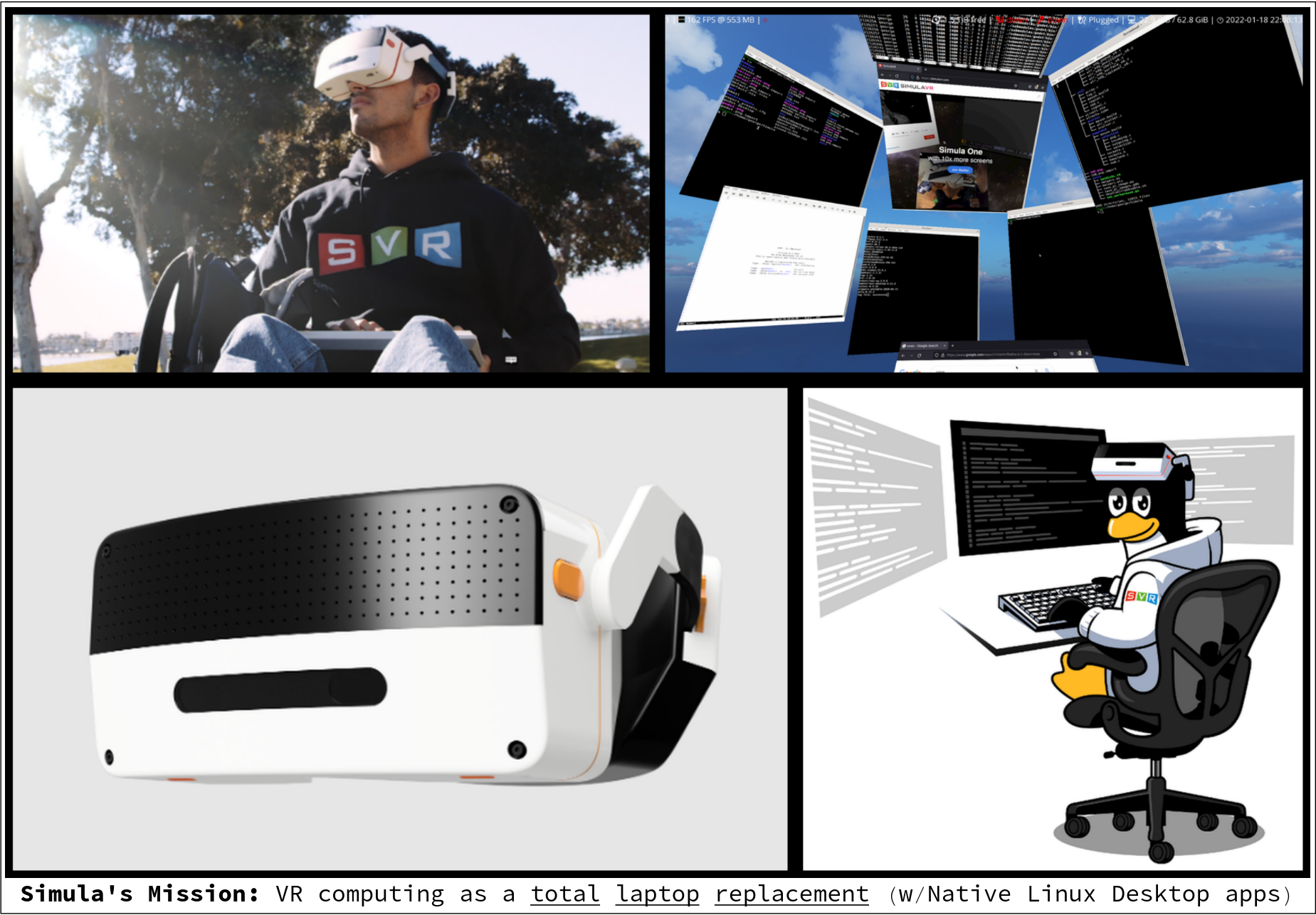
Nevertheless, the AVP is a huge step forward, and makes us more excited than ever to help bring VR capabilities to native Linux Desktop apps. We want to do this for the engineers and knowledge workers who need the extra capabilities in VR, and for the people who want to completely replace their laptop, rather than their tablets!
2 Simula One Chassis Adjustments
Flipping back to progress with the Simula One, here are some engineering problems we've recently faced:
- Glasses space. Our headset exterior has had trouble fitting user eyeglasses (that is: space around the eyes and facial interface is too constrained).
- Board space. We've had trouble finding internal space for our new boards & components (our FPGA board, the front-facing hand & eye tracking sensors, and the piezo motor for our IPD system).
- Cable management. Cable management is also tight for space.
To fix these problems: we decided to slightly enlarge our headset chassis and exterior, and to change the way that some of our components are mounted:
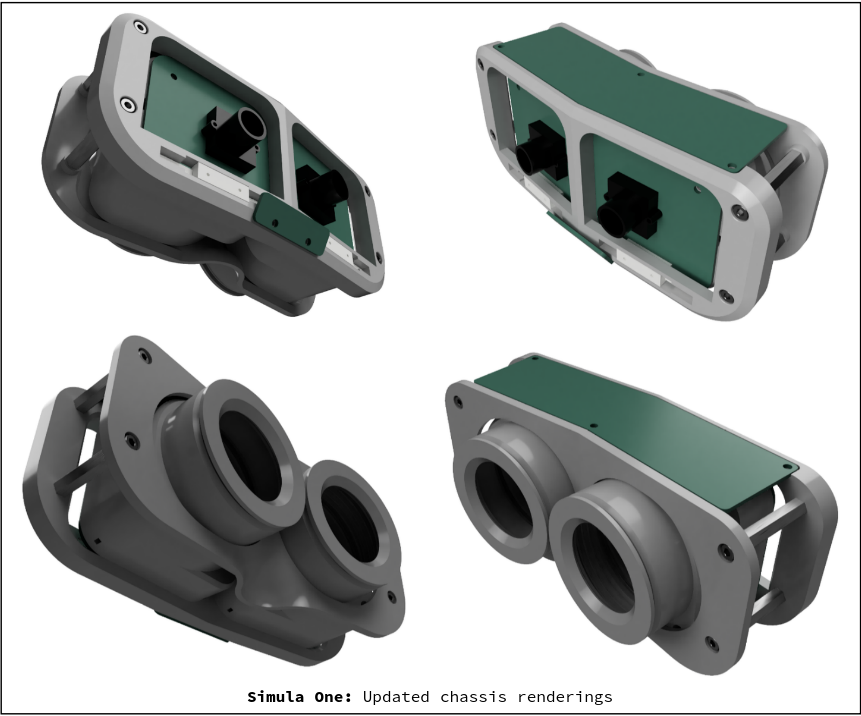
1.1 Lens Assembly & Piezo Motor System
The biggest changes have come to the way we are mounting our lens system and motors to our chassis.
2.1.1 Diopter Adjustment Mechanism (Inside View)
The following 3 pieces help form our new diopter adjustment mechanism: 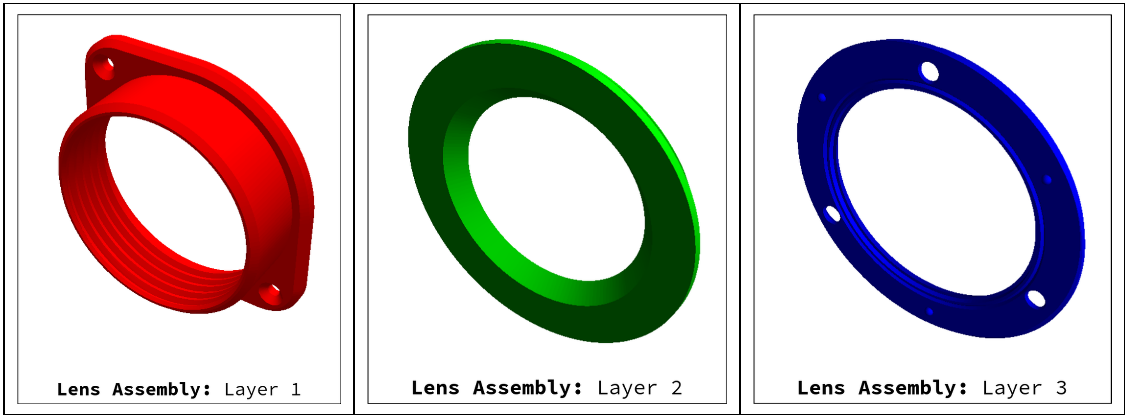
The green and blue pieces – which thread into the red piece – work together to sandwhich the eye lens closest to the user's eye. This mechanism can then be adjusted forwards and backwards to allow for diopter adjustment.
In terms of adjustments: we moved the screw holes on these pieces and made the lens opening slightly smaller (which makes less of the internals visible to the user).
2.1.2 Optical Layering (Side View)
A side view shows the way our 3-piece lens system is harnessed by the updated lens assembly:
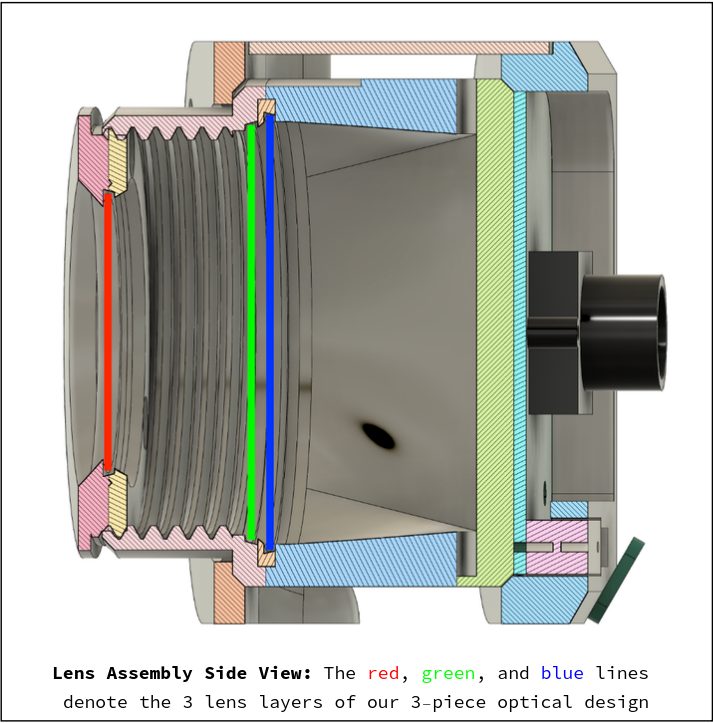
2.1.3 Piezo Motor (Rear View)
The following shows a rear view rendering of our headset chassis:
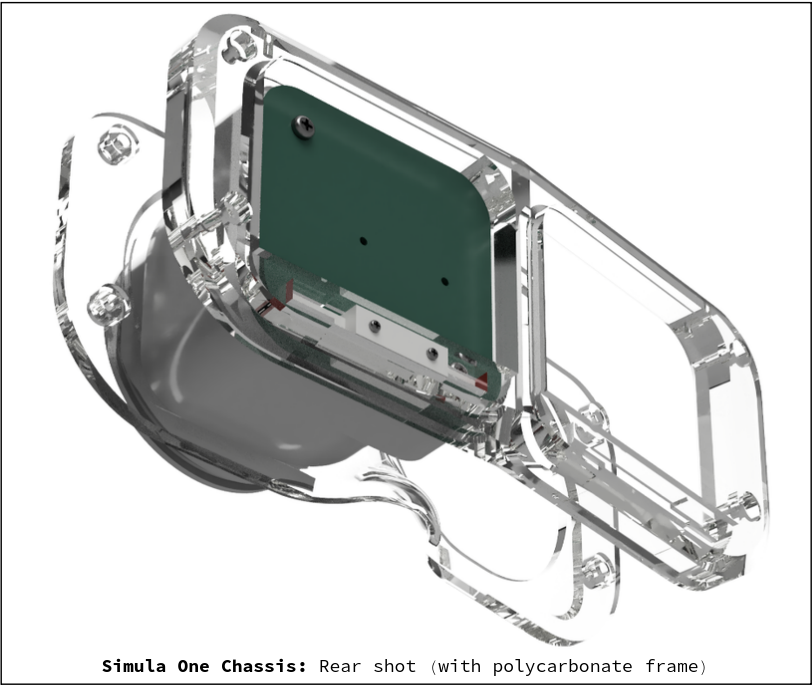
The frame is rendered in polycarbonate in order to draw attention to the rear display frame and its piezo motor which is used for IPD adjustment. Piezo actuators are basically the smallest motors on the market which produce enough force to manipulate the lenses without using gears. Here's a closeup of one:
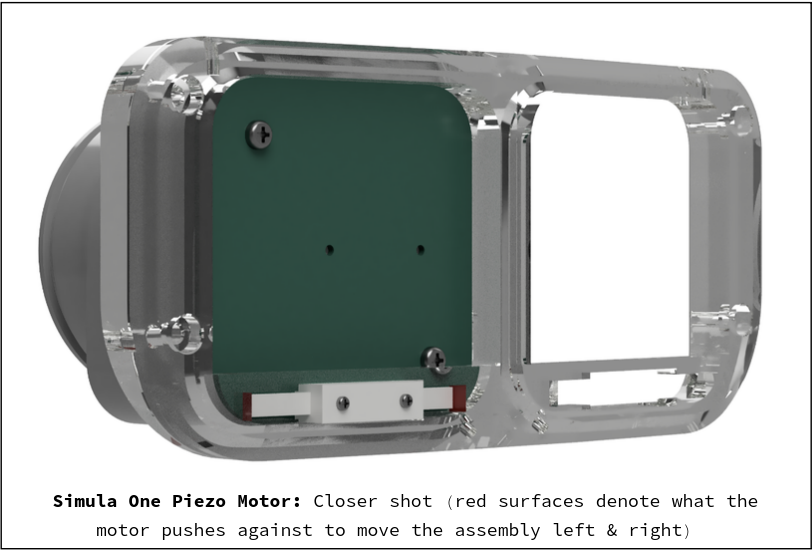
Each eye has its own piezo motor, which allows for assymetric IPD adjustment. Asymetric IPD adjustment is useful since most people's faces are actually somewhat asymmetric (the distance from the bridge of your nose to your left or right pupil can vary by as much as 5mm). Ideally, assymetric IPD adjustment happens automatically from embedded eye sensors, but it can still be adjusted via software (i.e.: inputting your IPD measurements into a GUI or Linux command line to adjust the piezo motors accordingly).
Here's a shot of an actual piezo motor:
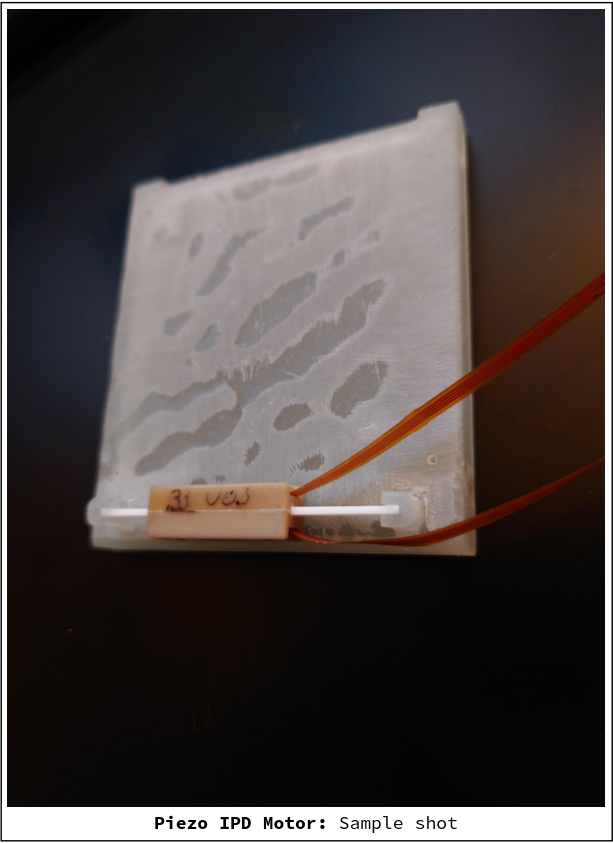
Since the two cables coming out of the piezo motor are kind of in an awkward position, our enlarged chassis design makes cable management slightly more manageable inside the headset.
2.1.4 M3 Fasteners & Standoffs
We also took advantage of our bigger chassis to switch the hodgepodge of M1-M2 fasteners inside our chassis to M3. Using larger fasteners makes it easier for us to work on our headsets (especially at lower volumes, where everything is hand assembled anyway).
Finally, using M3 standoffs on the rails that the lens assembly rides on above makes IPD adjustment a bit more stable.
2.2 Hand Tracking & RGB Camera Mounts
To avoid hand-tracking collisions with our piezo motors, we migrated from a "one mount per eye" to a "one mount per device" design:
![]()
Along similar lines, we also (slightly) adjusted the positioning of our front-facing RGB cameras. The extra space afforded by this design also helps out with our internal cable management around the front of the chassis.
2.3 FPGA & VXR Board Mounting Strategy
We altered the mounting strategy for our VXR and FPGA boards, moving from a "T-shaped" to a "Chevron shaped" mount:
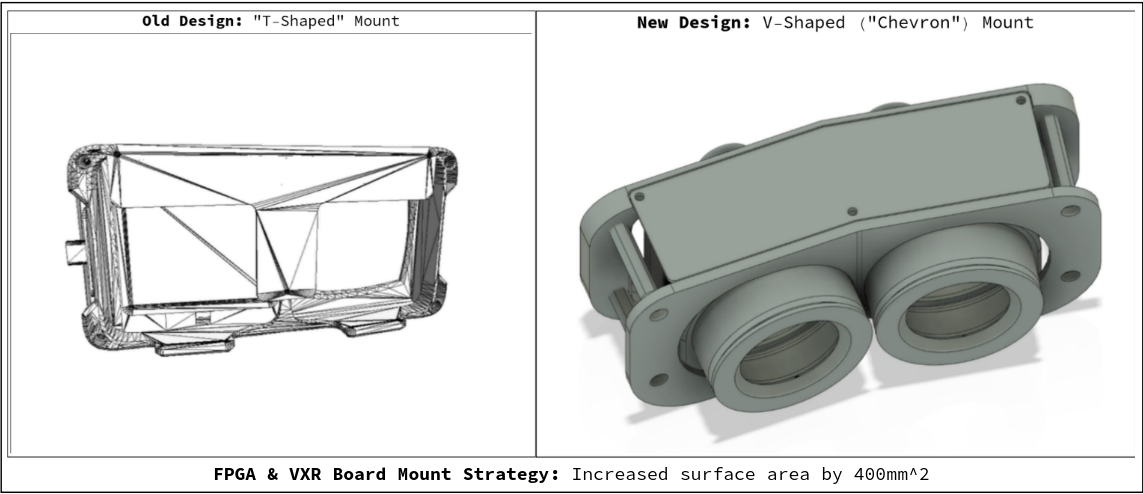
This new design increases the surface area of our mounting area by ~400mm2, which we expect to fully use for our FPGA board (still a work in progress).
3 Updated Preorder Agreement (for New Preorderers, Going Forward)
Finally, we want to flag an alteration to our Preorder Agreement.
We appreciate everyone's patience while our small team has been navigating the Valley of Hardware Hell. We owe a debt of gratitude to all of those who have put faith in us -- particularly our preorder backers and investors -- but also to anyone who has been following or sharing our progress (or who thinks what we're building is cool enough to spend even a few minutes to read about!).
But because we were unable to ship headsets by EOY 2023, we changed our Preorder Agreement to reflect an EOY 2024 target ship date:
If you have any questions about what this means, feel free to shoot an email to service@simulavr.com.
